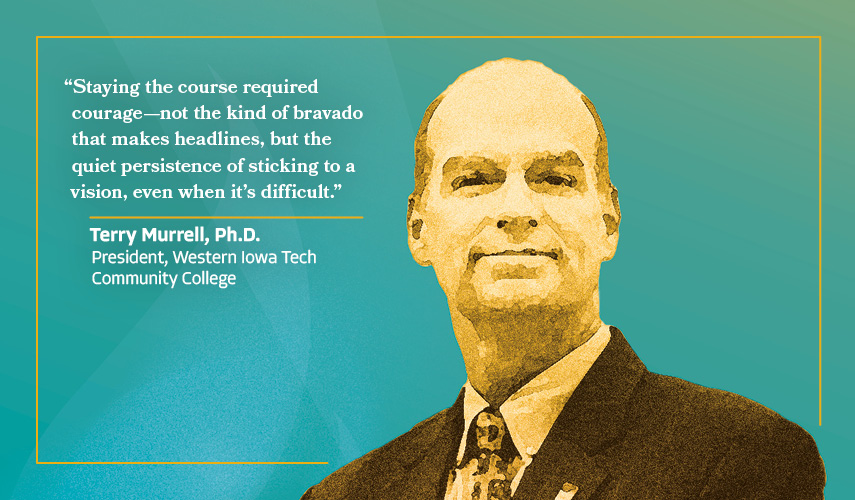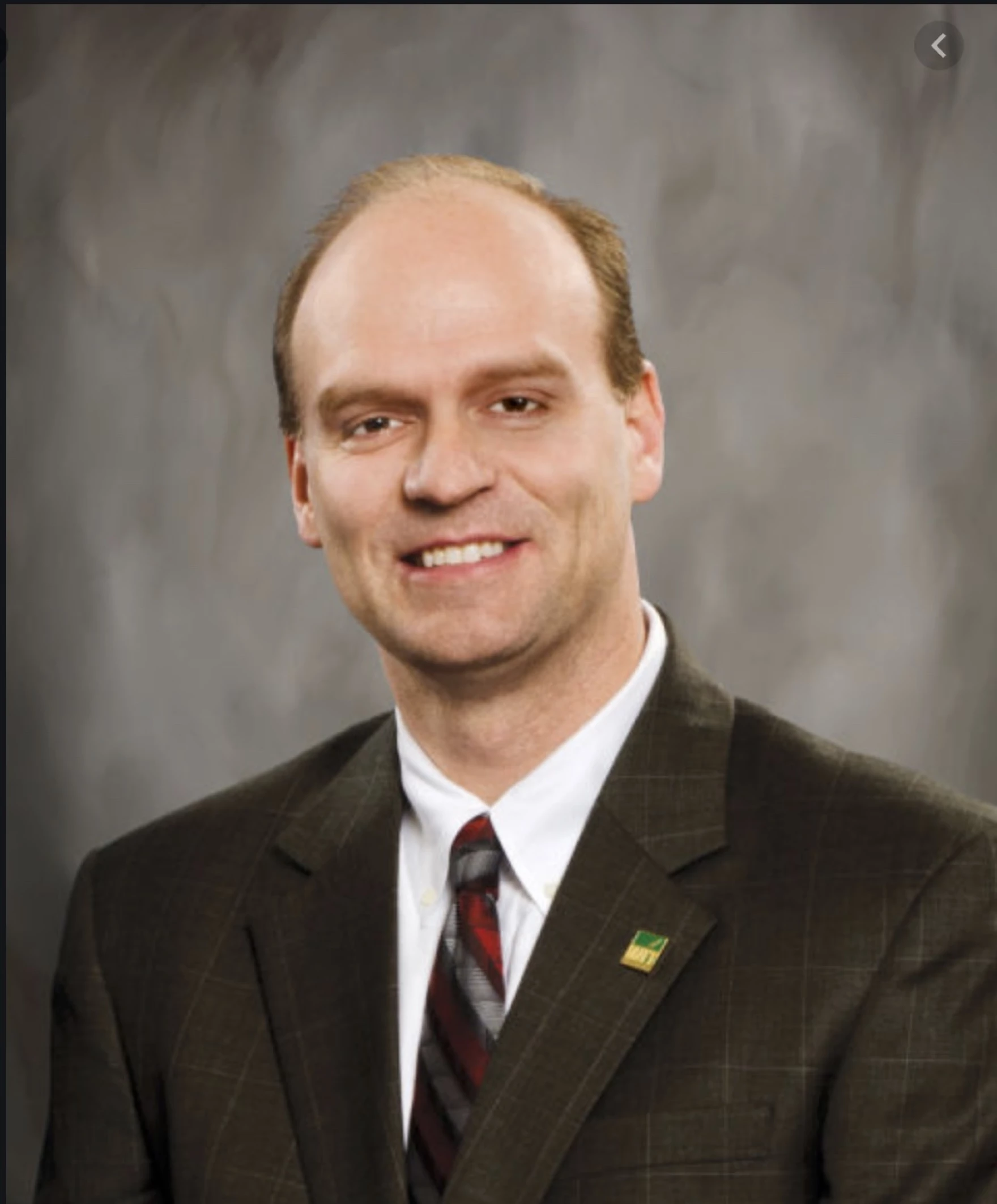
Courageous Leadership
The Courage to Change Lives
By Terry Murrell, Ph.D., President, Western Iowa Tech Community College (IA)
When I became president of Western Iowa Tech Community College in 2011, our institution faced a troubling reality. Our graduation rate was just 17% with a student loan default rate of 24%. These numbers told a concerning story. More of our students were leaving in worse shape—financially and academically—than when they arrived. That reality wasn’t just unacceptable; it was contrary to our mission. And it was clear that something had to change.
Back then, we were firmly rooted in our identity as an access institution, which is important, but access alone wasn’t enough. It wasn’t enough for our students to start their journey with us; they needed to finish it — with credentials in hand that would unlock better jobs, better opportunities, and better lives. This was not just about changing numbers on a report; it was about changing lives.
Staying the course required courage—not the kind of bravado that makes headlines, but the quiet persistence of sticking to a vision, even when it’s difficult

Terry Murrell, Ph.D.,
President
Western Iowa Tech Community College (IA)
So, we embarked on what we called the “Completion Initiative,” a focused effort to transform how we supported our students from enrollment to completion. Our original goal was to double the number of completers. But over the course of a decade, we increased our completion rate to over 46% by 2022—a more than 270% improvement. Our student loan default rate dropped from 24% to the low teens.
Changing the Language, Changing the Focus
One of the first shifts we made was linguistic but symbolic. We stopped talking about “graduation rates” and began focusing on “completion.” Graduation, after all, is just one path to completion. Our learners, a term we adopted instead of “students,” are diverse in their goals. Some pursue degrees, others certifications, and still others are here for workforce training, English language learning, or personal enrichment. By framing our mission around completion, we ensured that every corner of the institution saw itself as contributing to this goal.
This shift wasn’t just cosmetic; it required us to think differently about our responsibilities. If we were going to hold high expectations for our learners, we also needed to provide high levels of support. We needed to help them not just enroll, but persist and succeed.
From Shiny Objects to Strategic Focus
Early in my presidency, I realized that our strategic plans were often overloaded with initiatives—280 at one point—which diluted focus and impact. Inspired by Aristotle’s Rule of Three, I set a cap: three strategic priorities at any time. These priorities weren’t just operational goals; they were deeply tied to our mission. For years, every budget request and every institutional decision had to answer one question: How does this contribute to doubling the number of completers?
That singular focus created a ripple effect. We renovated our campus, not by building new structures, but by transforming existing spaces into environments where learners could thrive. Our facilities, once overlooked and outdated, became sources of pride. Even seemingly minor changes—like fixing potholes in the parking lot or repainting walls—sent a message: “You matter. Your success matters.”
Addressing Equity, Inclusion, and Belonging
Western Iowa Tech serves the most diverse and economically disadvantaged population of any community college in Iowa. While these challenges could have been excuses for low outcomes, I saw them as mandates for action. Our campus needed to be a place where every learner felt they belonged.
We launched an inclusion initiative that went beyond diversity numbers. It was about creating a culture where learners from every background could see themselves thriving here. This involved overhauling how we support learners, from tripling our mental health counseling staff to building a food pantry and health center directly on campus. We even provided every learner with a MacBook and access to subscription-based textbooks to level the playing field. For too long, some learners had access to tools for success while others didn’t. We eliminated that inequity.
Leveraging Partnerships for Impact
One of the most transformative lessons of this journey was the power of partnerships. During my first 100 days as president, I conducted a listening tour, meeting with more than a thousand people to understand our strengths and areas for improvement. What I discovered was striking: in every instance where our community praised something we were doing well, a partner was involved. Conversely, our areas of weakness were often where we were operating alone.
That insight reshaped how we approached collaboration. We stopped working with vendors and started building partnerships. Whether it was Apple, which helped us become a distinguished institution for technology, or local hospitals that enhanced our clinical programs, we sought relationships that were mutually beneficial and deeply engaged in our mission.
The Courage to Stay the Course
Leadership in higher education comes with challenges—budget constraints, political pressures, and the need to show results quickly. But real change takes time. It took us a decade to achieve our ambitious completion goals. Along the way, there was resistance. Some faculty feared that focusing on completion meant lowering academic standards. Others were skeptical of initiatives like universal technology access.
Staying the course required courage—not the kind of bravado that makes headlines, but the quiet persistence of sticking to a vision, even when it’s difficult. Courageous leadership, I’ve learned, is about doing what’s right by your mission, even in the face of criticism. It’s about holding high expectations and providing the support necessary to meet them.
Real Impact, Real Lives
One of the most humbling moments in this journey was calculating the human impact of our work. By increasing our completion rate, more than 1,750 learners—people who might have dropped out—earned their credentials over a decade. That’s 1,750 individuals now contributing to their communities, supporting their families, and living better lives because we refused to settle for 17%.
Today, we are building on the lessons of our Completion Initiative with a focus on inclusion and belonging. It’s a long road, and the work is far from done. But I believe the same principles apply: a clear vision, a focused strategy, and the courage to stick with it. To me, courageous leadership is not about chasing quick wins; it’s about making lasting change. And that makes all the difference.

